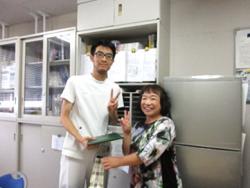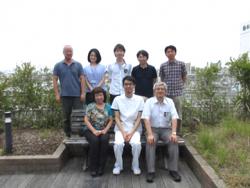国際・国内交流
劉明さん(汕頭大学医学院第4学年次)
Wonderful Life in Hyogo College of Medicine
I am Liu Ming, a 4th-year student in Shantou University. From July to August, I had 4 weeks fabulous and unforgettable experiences in Hyogo College of Medicine along with my 2 classmates.
The day we arrived in Japan was July 11th. When we got off the plane, I was impressed by kindness of people working at the airport, one of them encouraged me to work hard at the moment he saw the word, “study abroad” in my document. After we finished the immigration procedures, we met Ms. Kyoko Torii, who kindly waited at the airport and picked us up. Ms. Kyoko Torii was a beautiful and considerate teacher who leaded us to the guest house and gave us lots of guidance. And then, the students who had visited Shantou University as exchange students held a wonderful welcome party for us. We had delicious barbecue together and talked lots of things. We really enjoyed the time and appreciated their hospitality.
The Cardiology Department
My first 2 weeks was at the Cardiology Department. On the first day, I met Dr. Goda, who was the chief of my clinical clerkship. Dr. Goda was very kind and warmhearted. She printed a map of the hospital for me and showed me around places, because I needed to go to different buildings in the following days. And then, I met some staffs at CCU and the interventional group. All the doctors were very friendly and warmhearted. A couple days ago, I was worried about whether communication would go smoothly and whether I could get along well with Japanese doctors and students. But when I got time spending with them, the concern of “fitting in” problem vanished immediately. Although sometimes communication didn’t go well, we still got to understand each other by using Hanzi or mobile phone.
During my 2 weeks clinical clerkship, there were many doctors taking good care of me. Dr. Kashiwase was in charge of CCU. He was very knowledgeable. He taught me lots of theoretical knowledge by using several sheets of paper. It was amazing that his knowledge structures were well-developed that what he wrote down looked like the content in the textbook. He taught me lots of things like the Forrester Hemodynamic Subset, EA wave pattern and IABP and so on, of which I have never heard or learned in my college hospital. Dr. Imanaka was also a senior staff who experienced in Cardiology. He liked to ask me lots of questions, which were very challenging for me. From what he taught, I learned the Takotsubo cardiomyopathy, which I found a very interesting disease caused by the stress. And I reviewed many knowledge like the Allen’s sign, DVT and AF and so on through patients in CCU. Dr. Miki was a young doctor specializing in peripheral cardiovascular disease, who went to Stanford University for post-doc degree. He showed me the intervention of peripheral vessels which was very interesting. Dr. Daimon and Dr. Ohta were young staffs in CCU, they introduced cases to me every day and taught me how to see the imaging of a patient and how to interpret changing level of parameters in laboratory studies, which was really informative and enlightening. Dr. Akahori and Dr. Kishima were in the interventional group. Dr. Akahori was a charming man. He helped me to understand the procedure of the coronary angiography and intervention. He taught me how to recognize the coronaries on the screen and showed me a new type of pacemaker which would be put into use in the next couple months. Dr. Kishima was very kind and responsible. He brought me to the angiography room. It was my first time to get into an angiography room, wearing the lead aprons. To tell the truth, I had to admit that it was difficult for me to understand the catheter ablation during the observation which was also my very first time to watch one. Dr. Kishima tried his best to explain what the procedure was going on. No matter what, I really enjoyed it. It made me feel like I was one of the team in the interventional group.
What’s more, relationship between doctors and patients was very harmonious. Sometimes I could see doctors perform procedures on their knees. The doctors are always patient with the patients, speaking gently and explaining thoroughly.
I am really grateful for many doctors treating me warmly and teaching me passionately. When I was asked to attend to a Japanese meeting of case study, Dr. Goda kindly asked Dr. Fukui to translate Japanese for me, which I felt really touched.
The Biochemistry department
In this laboratory, professor Fujiwara was a very amiable and lovely teacher who guided me for 2 weeks. During this period, I learned some experimental skills such as culturing and maintenance of mammalian cells, immunohistochemistry, and western blot and so on. During the time we were waiting, we chatted a lot. Our conversation ranged widely. I really marveled at her understanding on many aspects of things. She always had her own opinion on many things. And she was always curious about many things. Therefore, doing research for her was just like that a child who felt curious would explore a new world. You can always find out how excited she was when she got some interesting results during experiments. One of the interesting things about professor Fujiwara was that she has never had a smartphone. She didn’t like having smartphone because she thought it enslaves human. Instead, she uses a phone with only a function of calling and texting. She had a wide range of knowledge, so there were literally nothing she couldn’t voice an opinion. I really admired her spirit. Curiosity is still robust at her age, which is very precious. Other staffs in the laboratory were also very friendly. Prof. Suzuki was also very cordial. At last, everybody held a farewell party for me. I really enjoyed the meal and was grateful for the generosity and kindness. I was much obliged to you, Prof. Fujiwara, Prof. Suzuki and everyone in the laboratory.
The Japanese culture is very fascinating and unique. During weekend, we witnessed and experienced fascination of Japan. People wear kimono to visit shrines or watch fireworks in summer festivals. People worship deer as their god in Nara, where deer live peacefully and harmoniously with human without limitation. The very spirit of craftsmanship is still preserved and carried on well. Many Japanese shrines and temples are appealing to many tourists. And almost everything is in order and everyone is polite.
When we talk about Japan, many things come out such as animation, Japanese Zen, digital equipment, and Kendo and so on. I used to know about Japan only through internet. And when I came to this fantastic country, I was really captivated by many aspects of Japan, which was truly a culture shock. And this was a good one. What saddened me was the period we could stay was only 4 weeks. I really wanted to stay longer, because there are many things worth exploring and learning.
Finally, I thank all of you who treated me warmly and kindly. Thank you for having this exchange program with our college. I am really grateful for your many kindnesses.

